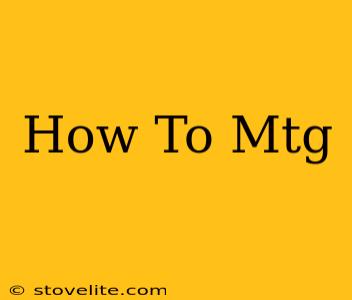Magic: The Gathering (MTG) can seem daunting at first, with its complex cards and strategic depth. But don't worry! This guide will walk you through the basics, helping you understand how to play this incredibly popular trading card game. Whether you're a complete beginner or just need a refresher, you'll find valuable information here.
Understanding the Basics: Cards and Gameplay
Magic: The Gathering is a game of strategy where two or more players battle using creatures, spells, and artifacts to deplete their opponent's life total to zero. Let's break down the key elements:
1. Types of Cards
- Creatures: These are your fighting force. They have power (attack) and toughness (defense) values.
- Spells: These cards provide a variety of effects, such as dealing damage, drawing cards, or enhancing your creatures. They're typically instant (playable at any time) or sorcery (playable only during your main phase).
- Artifacts: These are permanent objects with various abilities. They can be powerful weapons, defensive structures, or anything in between.
- Enchantments: These cards affect the game state, either globally or targeting specific players or creatures.
- Planeswalkers: Powerful characters with loyalty counters, they can attack and provide various abilities.
- Lands: These are essential for producing mana, the resource you use to cast spells and play creatures.
2. The Game's Structure
A typical game of MTG involves these phases:
- Beginning Phase: Draw a card.
- Upkeep Phase: Activate any abilities that trigger at this point.
- Draw Phase: Draw another card.
- Main Phase 1: You can play lands, creatures, and most spells.
- Combat Phase: Declare attackers, blockers, and damage is dealt.
- Main Phase 2: You can play more cards.
- End Phase: The turn ends.
3. Mana and Casting Spells
Mana is the fuel of the game. You tap your lands to produce mana of different colors (e.g., red, blue, green, black, white) needed to cast spells and summon creatures. Each card has a mana cost which determines how much mana you need to play it.
Building Your First Deck
Starting with a pre-constructed deck is a great way to learn the ropes. These decks are readily available at most game stores and online retailers. Once you're comfortable, you can build your own deck, focusing on a particular strategy or theme. A standard deck typically contains 60 cards, including lands and spells.
Key Considerations when Building a Deck:
- Choose a Theme/Strategy: Focus on a specific color combination or a particular style of gameplay (aggressive, controlling, etc.).
- Balance Your Card Types: Include a mix of creatures, spells, and lands to ensure a well-rounded deck.
- Synergy: Select cards that work well together to enhance their effectiveness.
Learning Resources and Community
- Online Tutorials: Numerous websites and YouTube channels offer comprehensive MTG tutorials for beginners. Search for "Magic: The Gathering tutorial" to find various learning resources.
- Local Game Stores: Your local game store is an excellent resource. They usually offer beginner events and have experienced players who can answer your questions.
- Online Communities: Join online forums and communities to connect with other players, ask questions, and learn from their experiences.
Mastering the Game: Advanced Strategies
As you progress, you'll delve into more advanced strategies and tactics, such as:
- Understanding card interactions: Learn how different cards interact with each other.
- Developing strategic decision-making: Learn to anticipate your opponent's moves and adjust your strategy accordingly.
- Mastering deck building: Fine-tune your deck to optimize its strengths and mitigate its weaknesses.
Learning Magic: The Gathering takes time and practice, but with patience and persistence, you'll soon become proficient in this captivating card game. Start with the basics, experiment, and most importantly, have fun!

